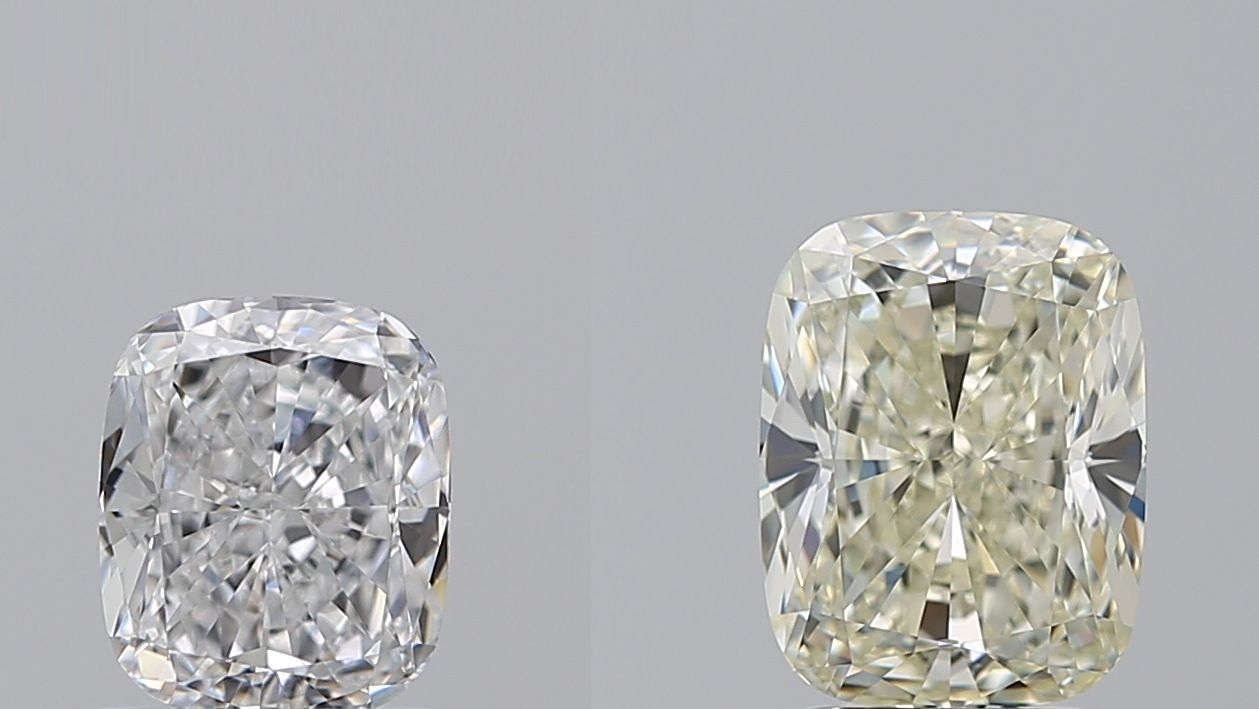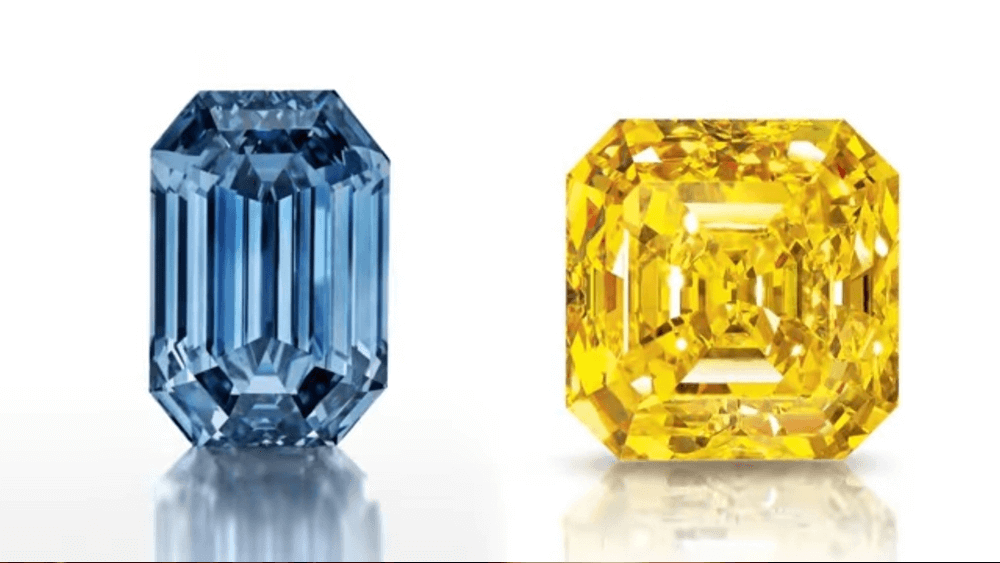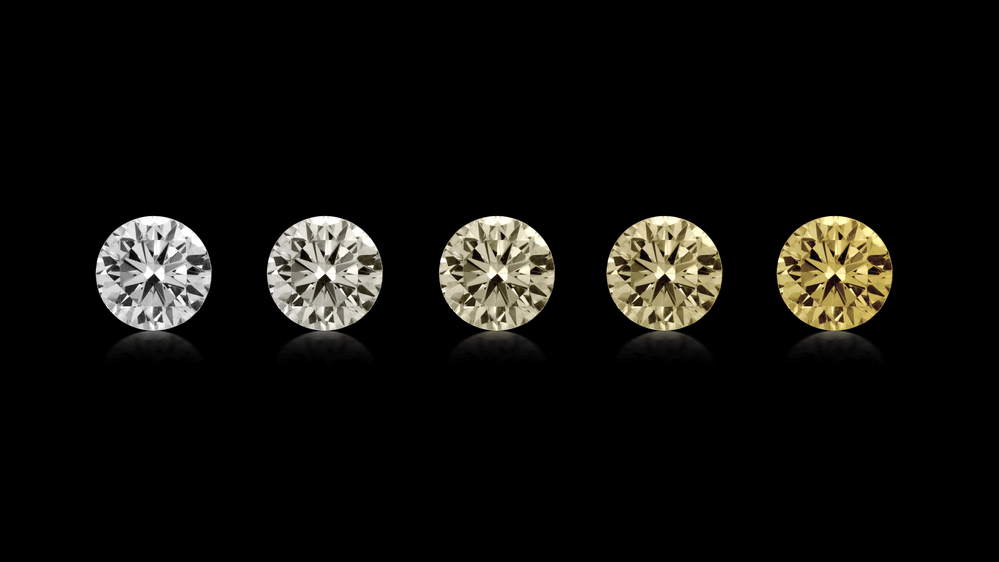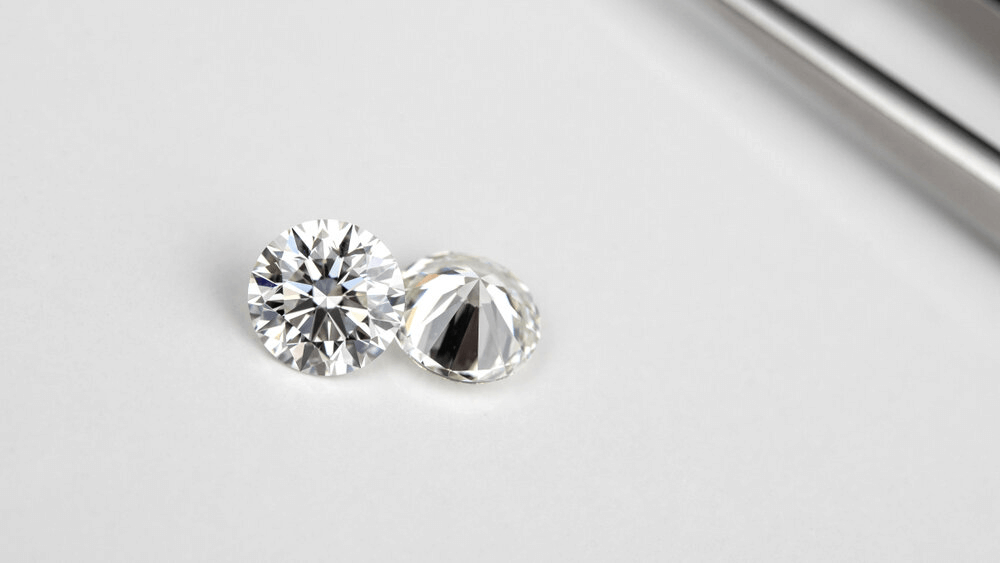The Allure of L and M Color Diamonds Exposed

By Gary A.

Edited by Olivia H.
Published Jul 29, 2024
Edited on Mar 31, 2025
Choosing L and M color diamonds can be a great way to balance budget and brilliance, especially for those who appreciate a warmer tone in their engagement ring.

Navigate This Guide:
- 7 Quick Tips for Buying a Diamond Engagement Ring: L and M Color Diamonds
- Introduction to L, and M Color
- Decoding the GIA Color Grading System to Understand K, L, and M Grades
- The Art of Diamond Color Grading
- K-M Diamond Color Range: A Comparative Analysis
- Clarity and Its Influence on Faint Color Diamonds
- Our Expert Take
- 10 FAQs
Before we dive deeper into the specifics, here are some practical tips to help guide your decision-making process:
7 Quick Tips for Buying a Diamond Engagement Ring: L and M Color Diamonds
When purchasing a diamond engagement ring, especially focusing on L and M color diamonds, it’s essential to understand and pay attention to the 4Cs—Color, Clarity, Cut, and Carat. Here are several practical tips to help you make an informed decision:
- Tip 1: Understand the Color Grade Implications
L and M color diamonds fall into a specific niche where the natural color starts becoming more apparent. They can offer great value, but it’s crucial to understand how the color grade can affect the appearance:
L Color Diamonds: They often exhibit a warmer tone compared to higher color grades. In yellow gold settings, this warmth can be less noticeable, making them a cost-effective choice for those who appreciate a vintage or traditional look. On the other hand, if you prefer a more traditional colorless appearance, L color diamonds might not meet your expectations.
M Color Diamonds: These diamonds have a more pronounced color tint. They can be a unique choice for those seeking a diamond with character and are often less expensive than higher color grades. However, the pronounced color may not appeal to those looking for a more colorless diamond.
- Tip 2: Prioritize Cut Quality
The cut of a diamond greatly influences its overall appearance and brilliance:
A well-cut L or M color diamond can display more brilliance and fire, which can partially mask the color tint.
Opt for cuts that enhance brightness, such as round or princess cuts, as they can help the diamond appear more vibrant.
- Tip 3: Evaluate Clarity with the Color in Mind
Clarity is an important aspect, but it should be considered in conjunction with the diamond’s color:
Inclusions may be more noticeable in L and M color diamonds due to the tinted background.
Choose a clarity grade where inclusions are not easily visible to the naked eye to ensure the diamond’s natural tint is the focal point.
- Tip 4: Consider Carat Weight Based on Personal Preference
Carat weight impacts the price, but it should align with personal preference and budget:
Larger carat L and M color diamonds can exhibit more color, which can be appealing if you prefer noticeable hues.
Smaller carats in these color grades can provide subtlety in color, suitable for those who desire only a hint of tint.
- Tip 5: Be Mindful of the Setting Color
The metal color of the ring setting can influence the appearance of L and M color diamonds:
Yellow gold can complement these diamonds by blending with their warmer tones.
White gold or platinum settings might contrast more with the diamond’s color, so consider this visual impact.
- Tip 6: View Diamonds in Various Lighting Conditions
Since color perception can change under different lighting, viewing the diamond in various settings is essential:
Observe the diamond under natural and artificial light to get a comprehensive view of its color.
Look for consistency in appearance across different lighting conditions.
- Tip 7: Compare Diamonds Side by Side
Comparison is key, especially with L and M color diamonds:
Comparing diamond colors should happen when the diamond is facing down table down for you have a side view.
Compare to Compare diamonds of the same color grade side by side to understand the variation within the grade.
Also, compare them with diamonds of slightly higher and lower color grades to see the differences clearly.
Now that you’ve got these practical tips, use Jeweler AI below to find the perfect engagement ring that suits your style and budget:
Introduction to L, and M Color
One of the most useful things about the GIA’s color scale is the fact that it is split into five subcategories. A clear diamond can be graded with one of 23 different grades, all of which are so subtly different from one another that only an expert can identify the difference. For shoppers, that could get confusing…if it weren’t for these categories:
- Colorless
- Near Colorless
- Faint
- Very Light
- Light
So, while we can’t ever expect to spot the difference between an F color diamond and a G color diamond, we can use the scale to understand how close to ideal they really are.
We spend a lot of time focusing on the Near Colorless grades – G, H, I, and J. This is because they offer the very best visual quality for money. They’re a lot cheaper than Colorless diamonds (D, E, and F), but so close to the top of the scale that there’s no risk of any visual color impacting the beauty of your diamond.
But what about the Faint grades? They’re only one step down from the Near Colorless grades, but they’re significantly cheaper, so why not opt for a K, L, or M diamond and put that saved money toward a higher carat weight?
Decoding the GIA Color Grading System to Understand K, L, and M Grades
K, L, and M are the 9th, 10th, and eleventh grades on the GIA’s color scale – remember, the scale starts at D, not A.
The Faint color category is defined by the GIA as representing color that is ‘still difficult to see by the untrained eye’.
This means that the GIA’s diamond experts are able to see it with (relative) ease, but that, if you don’t have much experience looking at diamonds, you may only detect a slight hint of yellow under certain lighting conditions.
The trouble is, ideally, you wouldn’t be able to detect any color at all – and that’s why the Near Colorless grades are so advantageous. While cheaper, they look like diamonds from the Colorless range – at least, outside of lab conditions.
The fact that untrained eyes can see color in Faint diamonds is a red flag, and what starts as a barely noticeable hint of yellow may one day feel very obvious to you as you spend more and more time looking at your diamond.
The Art of Diamond Color Grading
GIA diamond graders are experts in their field. In order to ensure consistency, they us controlled lighting conditions and master stones as references to determine the precise color grade of a diamond. While identifying the difference between a D and an E color diamond may seem impossible to us, it’s something they are trained to do – and highly adept at.
Impact of Color on Diamond’s Allure
While fancy color diamonds are highly coveted for their unique and eye-capturing hues, clear diamonds with noticeable color are considered to be poor quality, and undesirable choices for engagement rings – or any fine jewelry.
In other words, there’s a big difference between a diamond that is desirably yellow and a diamond with undesirable yellow coloring.
Unwanted yellow, which is what you’ll find in a K, L, or M diamond – even in a very small amount – can make a diamond look, well…dirty. It can really disappoint, since one of a diamond’s most defining traits is undermined by the presence of color.

K-M Diamond Color Range: A Comparative Analysis
For obvious reasons, a K color diamond is a lot more desirable for an engagement ring than an L or an M color diamond, simply because it’s the highest of the three grades on the color scale and as a result features the least amount of color .
For particularly small diamonds – i.e., diamonds that are rarely used in engagement rings—you may just get away with a K or an L color ed diamond. But, if you’re thinking about your centre stone, it really is best to avoid the faint color range altogether.
Clarity and Its Influence on Faint Color Diamonds
color and clarity are two key considerations for diamond shoppers, not least of all because they represent two of the four C. That said, clarity is a separate topic, and it really doesn’t have anything to do with color . In other words, a low clarity grade will not impinge on a diamond’s color, just as a low color grade won’t affect a diamond’s clarity.
The key thing to think about here is balancing the two in a healthy way. There’s no point in paying for a diamond with impeccable clarity if that diamond has a particularly low color grade. There’s no point in investing in a diamond with a D color grade if it has an I2 clarity grade since you will be investing a lot of money into something that just doesn’t look as good as it could.
If you’re considering a faint color diamond because your budget seems to push you in that direction, think about the clarity grades you’re looking at. If you’re focusing on diamonds with a high clarity grade—say, VS1 or VVS2 –then it’s really worth revisiting the drawing board and looking at a lower clarity grade so that you can focus on diamonds from the near colorless range rather than a K, L, or M diamond.
How Carat Weight Influences Color Perception
This is something else you really need to think about. Larger diamonds are more likely to show their color than smaller diamonds. In other words, if you have a six carat diamond next to a 0.5 carat diamond, and both diamonds have a color grade of L, then it is far more likely that you will spot the yellow in the six carat diamond then you will in the 0.5 carat diamond.
There’s no complex science at work here, it’s just a matter of surface area and the eye’s ability to see something when it’s larger.
This is why we recommend shoppers focusing on the one carat range look at the lower end of the near colorless grades, while shoppers focusing on larger diamonds should err on the side of caution and focus on the top end of the near colorless range.
What about Fluorescence?
This is a tricky 1. While it is true that the presence of a certain amount of fluorescence in a diamond can serve to improve the diamonds color , this is a very inexact science. The majority of fluorescent diamonds we see either feature and a noticeable amount of fluorescence, or a level of fluorescence that adversely affects the appearance of the diamond.
At WillYou, we do not sell diamonds with significant fluorescence—but it is worth noting that significant fluorescence tends to create cloudy diamonds. Fluorescence in just the right amount to improve the appearance of a diamonds color , is rare, and we wouldn’t recommend you try to find one.
Enhancing Beauty Through Metal Choices
One thing you may want to consider is the type of metal you are going to choose for the ring. We never recommend shoppers invest in a high color grade diamond, if they plan on setting that diamond within a yellow or rose gold. Since diamonds are not opaque, the color of the metal will reflect slightly through the centre of the stone, making a D or E color grade pointless, and something of a waste of money.
That said, in the majority of cases, we would advise shoppers to focus on the middle to lower end of the near colorless grades. The appearance of yellow or rose gold reflecting through the center of a diamond can be beautiful and subtle, but if the diamond already has a noticeable amount of yellow in it, then it could become too much too easily.
The one exception would be if you were using a more intrusive ring design. A bezel, for instance, cloaks the diamond in metal from all angles. If you are using yellow gold, a K diamond may just be suitable.
Our Expert Take
If you want to make the strongest choice possible for your engagement ring, then the faint color range really isn’t the place to be. Despite the fact that it is in very close proximity to the ideal color grades for shoppers, it’s just too far down the GIA’s scale for you to feel completely comfortable in your decision.
Buying a diamond with noticeable color can be a real disappointment. Beforehand, it’s easy to convince yourself that you won’t notice it, especially if you spend a lot of time indoors, under artificial lighting, or wearing warm-toned jewelry. But a diamond with noticeable traces of yellow just isn’t as beautiful as it could be, so focus on the near colorless range instead
10 FAQs
- Q1. What are L and M color diamonds?
- Answer: L and M color diamonds are categories within the GIA diamond color scale. They exhibit a warmer, more noticeable color tint compared to higher grades. L diamonds have a faint yellow hue, while M diamonds display a more pronounced color.
- Q2. Are L and M color diamonds a good choice for engagement rings?
- Answer: Yes, they can be excellent choices, especially if you appreciate unique, warm tones and are seeking a more budget-friendly option compared to higher color grades.
- Q3. How does the color of L and M diamonds affect their appearance?
- Answer: The color in L and M diamonds gives them a distinct warm, yellowish tint. This tint can add character and a vintage feel to the diamond. On the downside, this tint might be undesirable if you prefer a more traditional, colorless diamond look.
- Q4. What is the best setting for L and M color diamonds?
- Answer: Yellow gold settings complement L and M diamonds well, as they blend with the diamond’s warmth. However, the choice of setting can depend on personal preference and the desired contrast.
- Q5. Can the cut quality improve the appearance of L and M color diamonds?
- Answer: Yes, a well-executed cut can enhance the diamond’s brilliance and fire, which can make the color less noticeable and the diamond appear more vibrant.
- Q6. Are L and M color diamonds less expensive than higher color grades?
- Answer: Generally, yes. L and M color diamonds are often priced lower than higher color grades, making them attractive options for those on a tighter budget. However, their lower cost reflects the noticeable color tint, which might not appeal to everyone.
- Q7. How should I choose between an L and an M color diamond?
- Answer: Consider the level of color you’re comfortable with. If you prefer a subtler hue, go for an L color. If you’re okay with a more pronounced color, M might be suitable. Viewing the diamonds in person and comparing them can greatly help in making a decision.
- Q8. Is it necessary to get a diamond certificate for L and M color diamonds?
- Answer: Yes, a certificate from a reputable organization like GIA or AGS ensures that you are getting an accurately graded diamond. It’s important for verifying the color grade, clarity, cut, and carat weight.
- Q9. Do L and M color diamonds show inclusions more clearly?
- Answer: It depends on the individual diamond. Sometimes, the color can mask inclusions, but in other cases, inclusions might be more noticeable. It’s important to evaluate each diamond individually.
- Q10. How does lighting affect the appearance of L and M color diamonds?
- Answer: Different lighting conditions can affect how the color is perceived. It’s advisable to view these diamonds under various light sources to understand how their appearance might change.
Navigate diamond colors with Jeweler AI – Your gateway to the perfect engagement ring selection.
FOLLOW-UP GUIDE SERIES












